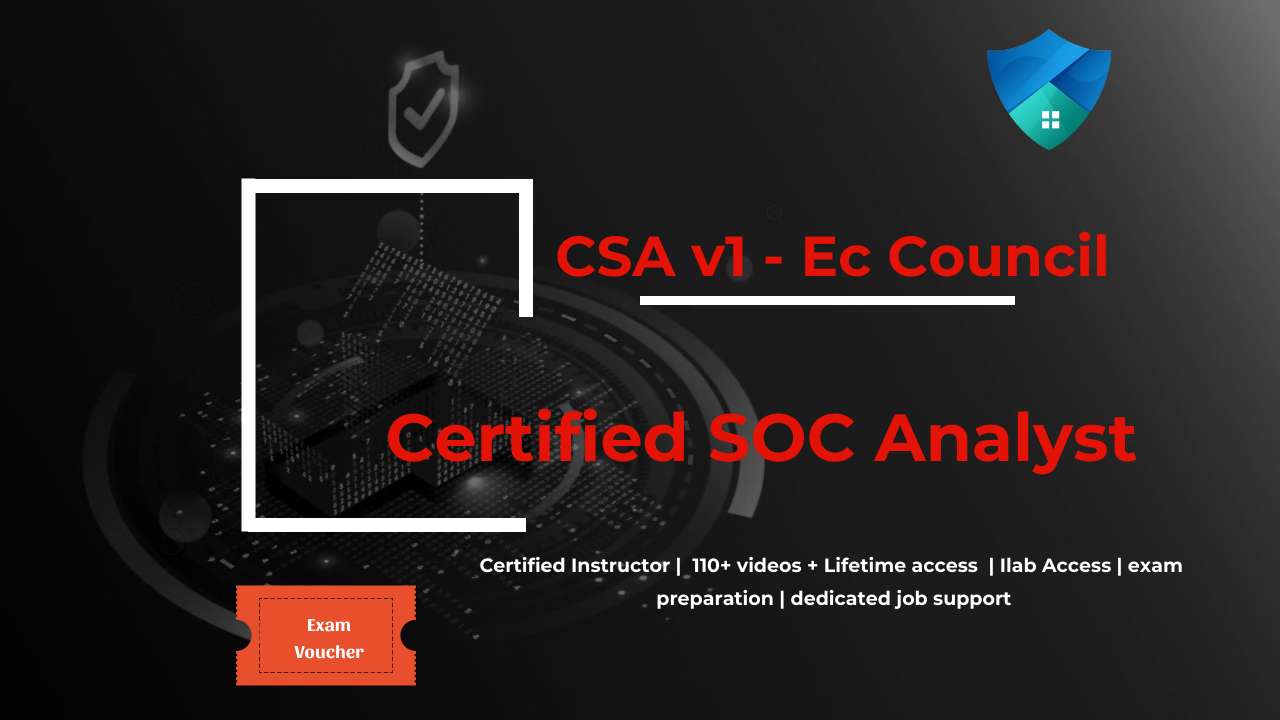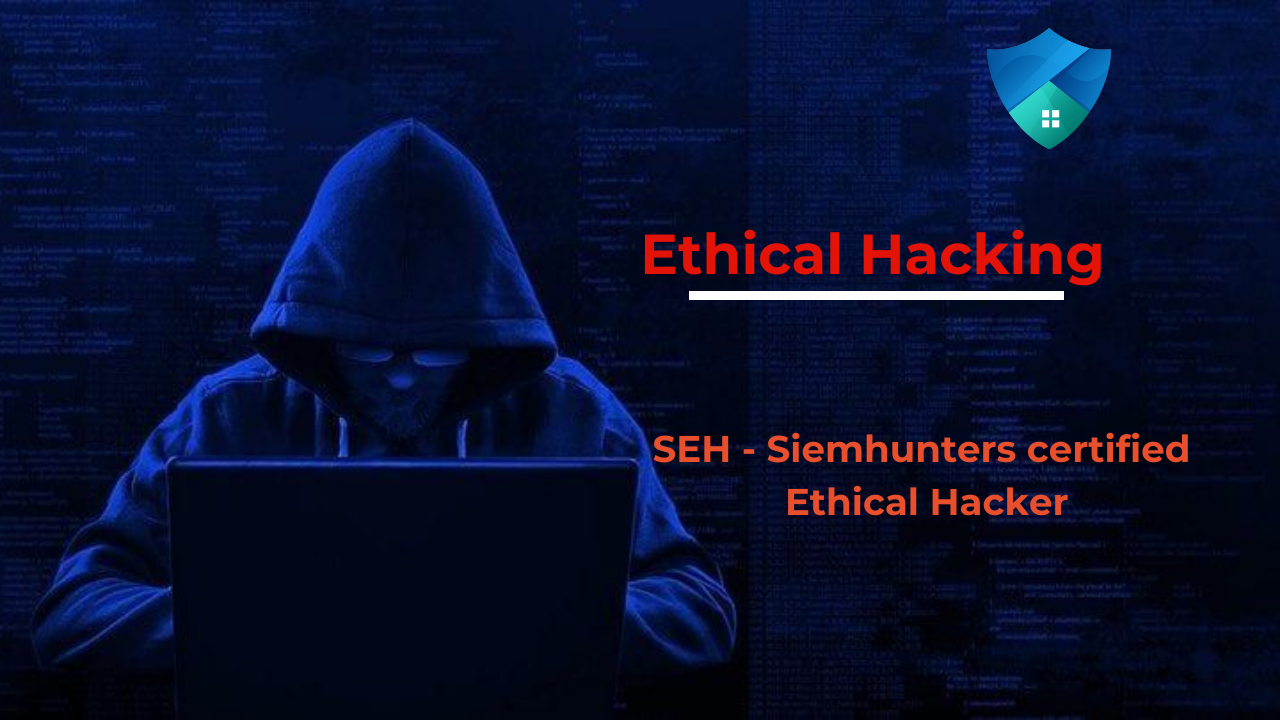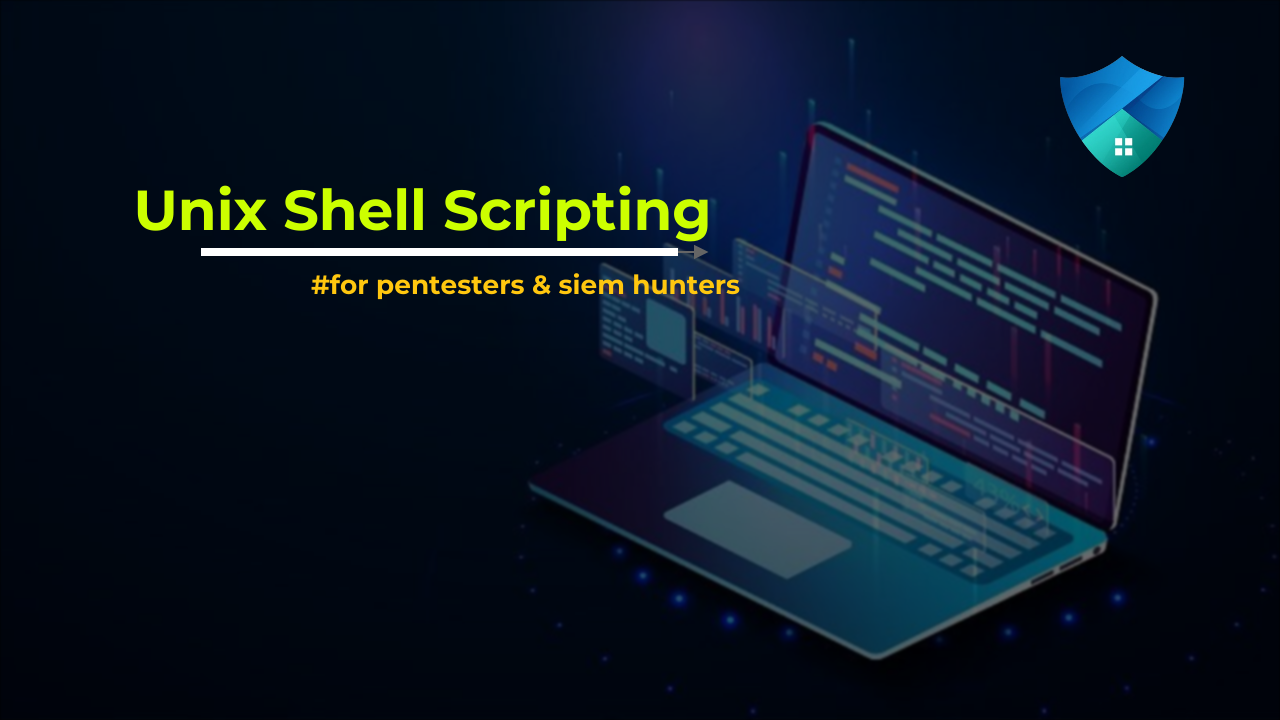CSA V1
admin
Last Update August 12, 2022
5.0 /5
(1)
39 already enrolled
5.00(1 Ratings)
CSA V1

Curriculum
87 Lessons
MODULE 1 – Security Operations and Management
lesson 1 – Security Management3:45
lesson 2 – Capabilities of SOC2:38
lesson 3 – Typical functions of Soc Operations2:30
lesson 4 – SOC Workflow1:22
lesson 5 – Components of SOC4:41
lesson 6 – Types of SOC Models4:09
lesson 7 – SOC Vs NOC2:05
lesson 8 – Security Operations4:03
lesson 9 – Need of SOC1:46
MODULE 2 – Understanding Cyber Threats, IoCs, and and Attack Methodology
Lesson – 1 Cyber Threats5:41
lesson 2 – Intent-Motive-Goal1:48
lesson 3 – Tactics-Technqiues-Procedures1:51
lesson 4 – Opportunity-Vulnerability-Weakness2:25
Lesson 5 – Network,Host,Application Level Attacks – 12:32
Lesson 5 – Network,Host,Application Level Attacks – 29:13
Lesson 5 – Network,Host,Application Level Attacks – 300:06:11
Lesson 5 – Network,Host,Application Level Attacks – 45:31
Lesson 5 – Network,Host,Application Level Attacks – 500:10:37
lesson 6 – Cyber Threat IoCs00:12:31
lesson 6 – malware Threats IOC – 28:34
lesson 7 – Hacking Methodologies8:00
lab 1 – Understanding the Working of SQL Injection Attacks00:05:50
lab 2 – Understanding the Working of XSS Attacks4:07
lab 3 – Understanding the Working of Network Scanning Attacks00:04:47
lab 4 – Understanding the Working of Brute Force Attacks3:50
lab 5 – Detecting and Analyzing IoCs using Wireshark00:13:59
MODULE 3 – Incidents, Events, and Logging
lesson 1 – Log , Event and Incident00:00
lesson 1 – Centralized Logging challenges – 15:40
lesson 1 – Centralized Logging challenges – 25:14
lesson 2 – Typical Log Sources00:00
lesson 3 – Need of Log3:01
lesson 4 – Logging Requirements00:01:41
lesson 5 – Typical Log Format00:02:37
lesson 6 – Local Logging – 16:39
lesson 6 – Local Logging – 24:24
lesson 6 – Local Logging – 35:36
lesson 6 – Local Logging – 49:05
lesson 6 – Local Logging – 500:05:04
lab 1 – Configuring, Monitoring, and Analyzing Windows Logs00:08:54
lab 2 – Configuring, Monitoring, and Analyzing IIS Logs00:09:06
lab 3 – Configuring, Monitoring, and Analyzing Snort IDS Logs00:22:33
MODULE 4 – Incident Detection with Security Information and event management
Lesson 1 – Security Infromation and Event Management (SIEM)1:55
lesson 2 – Need of SIEM2:07
lesson 3 – Typical SIEM Capabilities3:08
lesson 4 – SIEM Architecture and its Components3:56
lesson 5 – SIEM Solutions3:15
lesson 6 – SIEM Deployment – 14:47
lesson 6 – SIEM Deployment – 24:46
lesson 7 – Incident Detection with SIEM and Use Case Examples For Application Level Incident Detection8:20
lesson 8 – Use Case Examples For Insider Incident Detection5:01
lesson 9 – Use Case Examples For Network Level Incident Detection – 15:03
lesson 9 – Use Case Examples For Network Level Incident Detection – 29:00
lesson 10 – Use Case Examples For Host Level Incident Detection5:35
lesson 11 – Handling Alert Triaging and Analysis6:10
lab 1 – Host Level Incident Detection: Creating Splunk Use Case for Detecting and Generating Alert00:10:01
lab 2 – Application Level Incident Detection: Creating Splunk Use Case for Detecting and Generating – 100:07:03
lab 2 – Application Level Incident Detection: Creating Splunk Use Case for Detecting and Generating – 200:05:53
lab 3 – Network Level Incident Detection: Creating Splunk Use Case for Detecting and Generating Alert00:12:26
lab 4 – Host Level Incident Detection: Creating ELK Use Case for Monitoring Trusted Binaries Connect – 100:18:28
lab 4 – Host Level Incident Detection: Creating ELK Use Case for Monitoring Trusted Binaries Connect – 200:04:36
MODULE 5 – Enhanced Incident Detection with Threat intelligence
lesson 1 – Cyber Threat Intelligence (CTI)2:38
lesson 2 – Types of Threat Intelligence – 100:06:07
lesson 2 – Types of Threat Intelligence – 24:54
lesson 3 – Threat Intelligence-driven SOC2:00
lesson 4 – Benefit of Threat Intelligence to SOC Analyst1:22
lesson 5 – Threat Intelligence Use Cases for SOC Analyst2:07
lesson 6 – Integration of Threat Intelligence into SIEM1:46
lesson 7 – Threat Intelligence Use Cases for Enhanced Incident Response2:13
lesson 8 – Enhancing Incident Response by Establishing SOPs for Threat Intelligence00:02:07
lab 1 – Enhanced Incident Detection with Threat Intelligence00:30:11
lab 2 – Integrating OTX Threat Data in OSSIM00:06:33
MODULE 6 – Incident Response
lesson 1 – Incident response00:03:11
lesson 2 – SOC and IRT Collaboration00:01:17
lesson 3 – Incident Response (IR) Process Overview – 100:08:17
lesson 3 – Incident Response (IR) Process Overview – 200:05:17
lesson 3 – Incident Response (IR) Process Overview – 300:14:20
lesson 3 – Incident Response (IR) Process Overview – 400:07:16
lesson 3 – Incident Response (IR) Process Overview – 500:09:50
lesson 4 – Responding to Network Security Incidents00:09:58
lesson 5 – Responding to Application Security Incidents00:12:21
lesson 6 – Responding to Email Security Incidents5:12
lesson 7 – Responding to an Insider Incidents00:07:54
lesson 8 – Responding to an Malware Incidents00:04:34
lab 1 – Generating Tickets for Incidents00:22:22
lab 2 – Eradicating SQL Injection and XSS Incidents00:00
lab 3 – Recovering from Data Loss Incidents00:18:17
lab 4 – Creating Incident Reports using OSSIM4:51
Student Feedback
5.0
1 Rating
100%
0%
0%
0%
0%
Reviews (1)
joaquim da costa
2 years ago
The videos are disabled can you enable it
Write a review
Free
Free access this course
-
LevelIntermediate
-
Total Enrolled39
-
Last UpdatedAugust 12, 2022
-
CertificateCertificate of completion
Hi, Welcome back!
Curriculum
87 Lessons
MODULE 1 – Security Operations and Management
lesson 1 – Security Management3:45
lesson 2 – Capabilities of SOC2:38
lesson 3 – Typical functions of Soc Operations2:30
lesson 4 – SOC Workflow1:22
lesson 5 – Components of SOC4:41
lesson 6 – Types of SOC Models4:09
lesson 7 – SOC Vs NOC2:05
lesson 8 – Security Operations4:03
lesson 9 – Need of SOC1:46
MODULE 2 – Understanding Cyber Threats, IoCs, and and Attack Methodology
Lesson – 1 Cyber Threats5:41
lesson 2 – Intent-Motive-Goal1:48
lesson 3 – Tactics-Technqiues-Procedures1:51
lesson 4 – Opportunity-Vulnerability-Weakness2:25
Lesson 5 – Network,Host,Application Level Attacks – 12:32
Lesson 5 – Network,Host,Application Level Attacks – 29:13
Lesson 5 – Network,Host,Application Level Attacks – 300:06:11
Lesson 5 – Network,Host,Application Level Attacks – 45:31
Lesson 5 – Network,Host,Application Level Attacks – 500:10:37
lesson 6 – Cyber Threat IoCs00:12:31
lesson 6 – malware Threats IOC – 28:34
lesson 7 – Hacking Methodologies8:00
lab 1 – Understanding the Working of SQL Injection Attacks00:05:50
lab 2 – Understanding the Working of XSS Attacks4:07
lab 3 – Understanding the Working of Network Scanning Attacks00:04:47
lab 4 – Understanding the Working of Brute Force Attacks3:50
lab 5 – Detecting and Analyzing IoCs using Wireshark00:13:59
MODULE 3 – Incidents, Events, and Logging
lesson 1 – Log , Event and Incident00:00
lesson 1 – Centralized Logging challenges – 15:40
lesson 1 – Centralized Logging challenges – 25:14
lesson 2 – Typical Log Sources00:00
lesson 3 – Need of Log3:01
lesson 4 – Logging Requirements00:01:41
lesson 5 – Typical Log Format00:02:37
lesson 6 – Local Logging – 16:39
lesson 6 – Local Logging – 24:24
lesson 6 – Local Logging – 35:36
lesson 6 – Local Logging – 49:05
lesson 6 – Local Logging – 500:05:04
lab 1 – Configuring, Monitoring, and Analyzing Windows Logs00:08:54
lab 2 – Configuring, Monitoring, and Analyzing IIS Logs00:09:06
lab 3 – Configuring, Monitoring, and Analyzing Snort IDS Logs00:22:33
MODULE 4 – Incident Detection with Security Information and event management
Lesson 1 – Security Infromation and Event Management (SIEM)1:55
lesson 2 – Need of SIEM2:07
lesson 3 – Typical SIEM Capabilities3:08
lesson 4 – SIEM Architecture and its Components3:56
lesson 5 – SIEM Solutions3:15
lesson 6 – SIEM Deployment – 14:47
lesson 6 – SIEM Deployment – 24:46
lesson 7 – Incident Detection with SIEM and Use Case Examples For Application Level Incident Detection8:20
lesson 8 – Use Case Examples For Insider Incident Detection5:01
lesson 9 – Use Case Examples For Network Level Incident Detection – 15:03
lesson 9 – Use Case Examples For Network Level Incident Detection – 29:00
lesson 10 – Use Case Examples For Host Level Incident Detection5:35
lesson 11 – Handling Alert Triaging and Analysis6:10
lab 1 – Host Level Incident Detection: Creating Splunk Use Case for Detecting and Generating Alert00:10:01
lab 2 – Application Level Incident Detection: Creating Splunk Use Case for Detecting and Generating – 100:07:03
lab 2 – Application Level Incident Detection: Creating Splunk Use Case for Detecting and Generating – 200:05:53
lab 3 – Network Level Incident Detection: Creating Splunk Use Case for Detecting and Generating Alert00:12:26
lab 4 – Host Level Incident Detection: Creating ELK Use Case for Monitoring Trusted Binaries Connect – 100:18:28
lab 4 – Host Level Incident Detection: Creating ELK Use Case for Monitoring Trusted Binaries Connect – 200:04:36
MODULE 5 – Enhanced Incident Detection with Threat intelligence
lesson 1 – Cyber Threat Intelligence (CTI)2:38
lesson 2 – Types of Threat Intelligence – 100:06:07
lesson 2 – Types of Threat Intelligence – 24:54
lesson 3 – Threat Intelligence-driven SOC2:00
lesson 4 – Benefit of Threat Intelligence to SOC Analyst1:22
lesson 5 – Threat Intelligence Use Cases for SOC Analyst2:07
lesson 6 – Integration of Threat Intelligence into SIEM1:46
lesson 7 – Threat Intelligence Use Cases for Enhanced Incident Response2:13
lesson 8 – Enhancing Incident Response by Establishing SOPs for Threat Intelligence00:02:07
lab 1 – Enhanced Incident Detection with Threat Intelligence00:30:11
lab 2 – Integrating OTX Threat Data in OSSIM00:06:33
MODULE 6 – Incident Response
lesson 1 – Incident response00:03:11
lesson 2 – SOC and IRT Collaboration00:01:17
lesson 3 – Incident Response (IR) Process Overview – 100:08:17
lesson 3 – Incident Response (IR) Process Overview – 200:05:17
lesson 3 – Incident Response (IR) Process Overview – 300:14:20
lesson 3 – Incident Response (IR) Process Overview – 400:07:16
lesson 3 – Incident Response (IR) Process Overview – 500:09:50
lesson 4 – Responding to Network Security Incidents00:09:58
lesson 5 – Responding to Application Security Incidents00:12:21
lesson 6 – Responding to Email Security Incidents5:12
lesson 7 – Responding to an Insider Incidents00:07:54
lesson 8 – Responding to an Malware Incidents00:04:34
lab 1 – Generating Tickets for Incidents00:22:22
lab 2 – Eradicating SQL Injection and XSS Incidents00:00
lab 3 – Recovering from Data Loss Incidents00:18:17
lab 4 – Creating Incident Reports using OSSIM4:51
Your Instructors
Student Feedback
5.0
1 Rating
100%
0%
0%
0%
0%
Reviews (1)
joaquim da costa
2 years ago
The videos are disabled can you enable it
Write a review
Course categories
Related Courses






